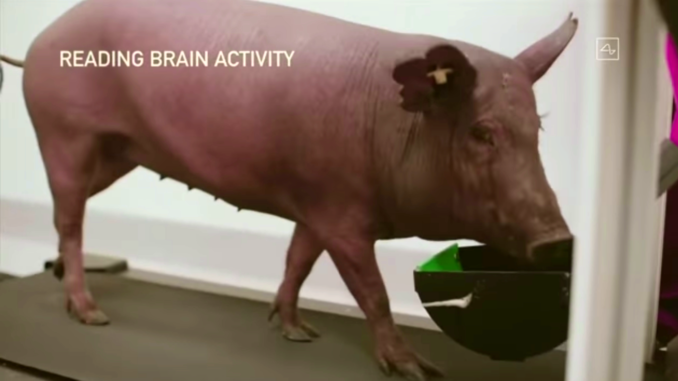
If you’ve been worried about the inevitability of artificial intelligence (AI), and the advent of the singularity, here’s something truly ominous: cybernetic pork; Sus domesticus with access to unlimited computing power; cy-porks.
Just kidding. Kinda sorta.
Neuralink is a startup company that has been busy developing and testing miniaturized brain implants. They employ an interdisciplinary staff of approximately 100, and are actively looking to hire more. Founded in 2016, Neuralink is funded to the tune of $158 million (that’s a big tune) – $100 million came from co-founder Elon Musk (dun-dun–DUN!). Musk and company executives presented the device and three pigs, who had the implant surgically inserted, in a press conference and demonstration streamed live online on Friday, August 28, 2020.
At this time, the size of the computer chip has been reduced to a diameter of 22.5 millimeters (0.9 inch) and a thickness of 8 millimeters. The company’s goal for the device, with which they hope to start human trials by the end of the year, is to treat various conditions including depression, insomnia, memory loss, hearing loss, Alzheimer’s, dementia, spinal cord injuries including paralysis, and more.
The concept isn’t new. Electronic devices have been used for years to stimulate the brains of people suffering from hearing loss as well as Parkinson’s disease. With the older technology, the patient has wires inserted into their brains, but the wires run out of the skull through a port and attach to a small box of electonics which provides electrical stimulation to the brain. The box of electronics is worn on the patient’s belt or other clothing.
The difference between the old tech and the new tech is miniaturization, with Neuralink’s computer chip completely inside the patient’s skull, and no external wires or electronic box. There are numerous tiny wires coming out of the chip, which interface with neurons of the patient’s brain, but not with anything external. The implanted computer chip is otherwise ‘wireless’ – it communicates with external computers wirelessly and can be recharged wirelessly. Musk calls it, “a Fitbit in your skull with tiny wires”.
By the way, once they work out the technical details and perfect this gizmo, Neuralink eventually wants their implant to be a human-brain interface to allow communication with artificial intelligence. Musk infamously has been an AI critic and alarmist in the past, but now says, “If you can’t beat em, join em”. Cyborg reality could become a thing. Maybe they’ll interface Sus domesticus brains, too, who knows?
Question of the Night: Do you eat pork, ham, bacon, etc., and if so, how do you like it prepared?
